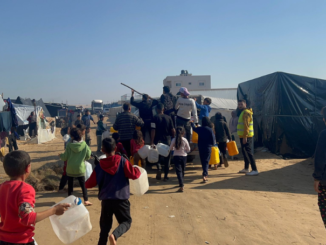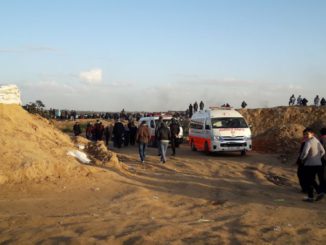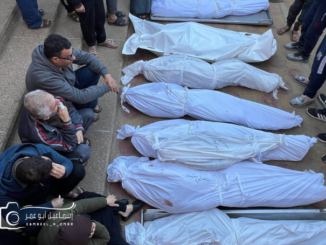
By Ramona Wadi
It is time, once again, for the hyphenated “Israel-Gaza” paradigm – an invention that suits mainstream narratives. As the media mulls the possibilities of another Israeli military aggression against Palestinians in Gaza, it is pertinent to take a step back to remember how, since “Operation Protective Edge”, Israel regularly hinted at another, definite round of violence to eliminate Hamas, with the added bonus, from an Israeli perspective, of inflicting a high percentage of collateral damage.
As speculation mounts amid reports of airstrikes and rocket fire; the latter enhanced through numbers that purposely render Israeli violence a purported retaliation, Israel is assured of an audience that is ready to absorb whatever trajectory it decides upon. There is, of course, a difference in terms of whether this will be a temporary round or a prolonged aggression against Palestinians in Gaza – the latter would render the enclave’s geophysical space inhabitable before the UN’s estimated date of 2020.
Yet, in terms of media depiction, there is already a premeditated slant that differentiates not only between rocket fire and airstrikes but also involvement and dissociation respectively. Rocket fire is the subject of statistics while airstrikes imparted as an acceptable method of containment. The concept of involvement and, as a result, violence, is shifted upon Hamas, as opposed to the Israeli incursion in Gaza which the resistance had every right to disrupt.
Already, the Palestinians murdered by Israel have faded further into the background to distort the unfolding aggression into simplified airstrikes versus rockets. Amplifying rocket damage is the current strategy, despite Gaza already having suffered more in terms of destruction.
In a series of photographs, Haaretz imparts this normalized strategy with close up views of rocket damage and Israelis sheltering from rockets. By contrast, the distant imagery of airstrikes in Gaza – an orange glow in the sky or an explosion juxtaposed against the cityscape, enable a dissociated processing of violence which was impossible during “Operation Protective Edge” due to the incessant footage of butchered bodies.
So far, the reports are focusing on weaponry statistics, seeking to portray Hamas on a par with Israel’s military might. This, however, is not reminiscent only of Israel’s popularised assaults on Gaza, but a strategy that is implemented consistently as a precursor to such magnified violence. It is as yet unclear what direction the current violence will take, but the longer Israel persists in drawing out this fabricated equivalence, the more its massacres will be normalized within the international community.
Ceasefires are convenient trajectories for the international community to navigate. It is one thing to speak of agreements, and another to comprehend the realities of a civilian population incarcerated with no way of escape.
Mainstream narratives will not spell out the confines of the experimentation zone and the international community has no intention of prioritizing the safety of Palestinians in Gaza. The only alternative is to construct a false image of Hamas and Gaza as indistinguishable; a preliminary requirement that allows Israel to prolong its cycle of intermittent and sustained massacres depending on its priorities and agendas.
– Ramona Wadi is a staff writer for Middle East Monitor, where this article was originally published. She contributed this article to PalestineChronicle.com.








#OpenShuhadaStreet 2018 Campaign http://www.yashebron.org/open_shuhada_street
#BDS4Israel & #Justice4Palestine to #StopIsraeliApartheid, Terror, Ethnic cleansing, Annexation of Palestine & fulfills UN resolutions #194 & #242!
#BDS works well against apartheid in #Israel as it did in South Africa!
Vorwärts und nicht vergessen … https://youtu.be/Wbot4iuMX-E
#BDS4Israel to #EndGazaSiege and the #ZionistTerror on #Gaza!